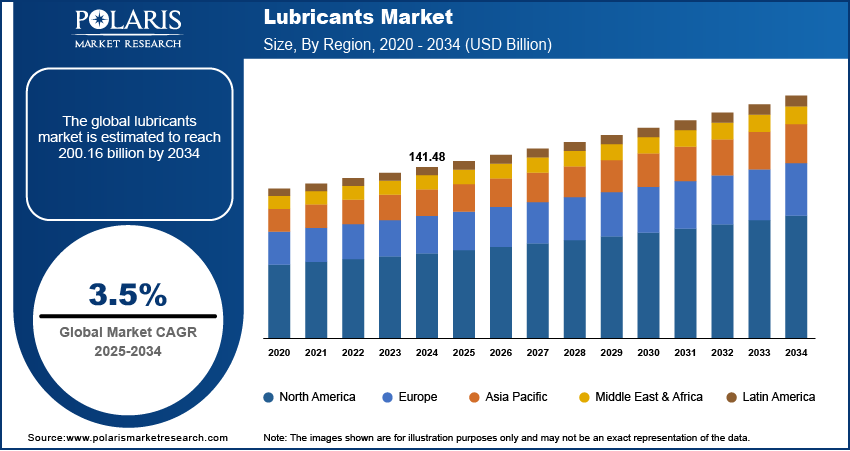Lubricants Market Projected to Reach USD 200.16 Billion by 2034, Growing at a CAGR of 3.5%

The global lubricants market was valued at USD 141.48 billion in 2024 and is expected to grow from USD 146.37 billion in 2025 to USD 200.16 billion by 2034, registering a CAGR of 3.5% during the forecast period from 2025 to 2034.
Key Market Trends & Insights
- Rising use of synthetic and bio-based lubricants for better performance and environmental compliance
- Growing industrial automation and machinery usage
- Increasing demand for fuel-efficient and long-life lubricants
- Technological advancements such as smart lubrication systems
- Expansion in emerging economies with growing transportation and manufacturing sectors
Market Size & Forecast
- Market size value in 2025 – USD 146.37 billion
- Revenue forecast in 2034– USD 200.16 billion
- CAGR – CAGR of 3.5% from 2025 to 2034.
Market Overview
The lubricants market involves products used to reduce friction, wear, and overheating in mechanical components. It serves various sectors, including automotive, industrial, marine, and aerospace. Growing industrialization and demand for performance efficiency are central to market expansion.
Request for Free Sample:
https://www.polarismarketresearch.com/industry-analysis/lubricants-market/request-for-sample
Key Market Growth Drivers
- Expansion of the Automotive and Heavy Machinery Industries
The growth of automotive manufacturing and infrastructure development is increasing the demand for lubricants. These sectors rely on high-performance lubricants to ensure smooth engine and machinery operation, reduce friction, and minimize wear and tear. - Need for Energy-Efficient Solutions
As industries aim to reduce energy consumption and improve overall efficiency, there is a growing need for lubricants that enhance fuel economy and reduce mechanical losses. Advanced synthetic lubricants are being developed to meet these needs. - Increased Marine and Aviation Activities
The expansion of global trade and travel is driving the marine and aviation industries, both of which require high-performance lubricants for engines and auxiliary systems. These lubricants must withstand extreme conditions and ensure reliable operation. - Rising Investments in Renewable Energy Requiring Specialized Lubricants
The renewable energy sector, particularly wind and solar, uses heavy rotating equipment such as turbines. These systems demand specialized lubricants that can operate under high stress and varying environmental conditions. - Emphasis on Equipment Longevity and Maintenance
To reduce downtime and extend the life of machinery, industries are increasingly focusing on preventive maintenance. High-quality lubricants are essential in minimizing friction, protecting components, and ensuring optimal equipment performance over time.
Market Challenges
- Fluctuating Crude Oil and Base Oil Prices
Lubricants are often petroleum-based, making their production costs sensitive to fluctuations in crude oil prices. Volatility in the raw material market affects profit margins and pricing stability. - Regulatory Pressures on Emissions and Waste Management
Stringent environmental regulations are pushing manufacturers to reduce emissions and improve waste handling. This often requires changes in formulation, increased R&D costs, and compliance investments. - Reduced Lubricant Usage in Electric Vehicles
EVs require significantly fewer lubricants than traditional internal combustion engine vehicles, particularly engine oils. As the EV market grows, traditional lubricant demand in the automotive sector is expected to decline. - Challenges in Lubricant Recycling and Disposal
Used lubricants can pose environmental hazards if not properly handled. Effective recycling and safe disposal systems are complex and expensive, especially in regions with inadequate waste management infrastructure. - Limited Awareness in Some Developing Regions
In certain emerging markets, knowledge about the benefits of using high-quality or synthetic lubricants is low. This limits market penetration and adoption, particularly where price sensitivity is high.





